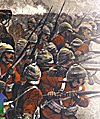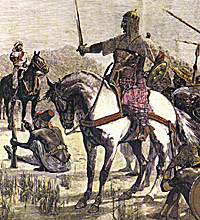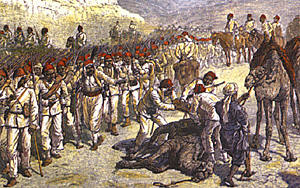
 Mahdists armed with lances, sabres, and shields were no match for ordered ranks of Redcoats who faced and defeated them at El Teb.
Mahdists armed with lances, sabres, and shields were no match for ordered ranks of Redcoats who faced and defeated them at El Teb.
The defeat of Baker Pasha's Egyptian army near Trinkitat on 4th February 1884 was no direct concern, of the British government. No British troops had been involved and those British citizens present were legally in the employ of Egypt. Egypt and its' previous overlord Turkey had a history of using non-Egyptians, even Christians, where these were the best or cheapest available for the job. When the British General Hicks and his staff were killed together with a large Egyptian army in 1883, the government in Cairo was left to pick up the pieces.
 This illustration depicting an Egyptian detachment negotiating with Mahdists shows the wide influence of al-Mahdi among the varied peoples of NE Africa and the Middle East. Leading the Mahdists, a Darfur warrior on horseback wears medieval chain mail while around him Nubians, Kordolanis and Arabs stand as unlikely allies swayed by the influence of at-Mahdi.
This illustration depicting an Egyptian detachment negotiating with Mahdists shows the wide influence of al-Mahdi among the varied peoples of NE Africa and the Middle East. Leading the Mahdists, a Darfur warrior on horseback wears medieval chain mail while around him Nubians, Kordolanis and Arabs stand as unlikely allies swayed by the influence of at-Mahdi.
Less than a year later a smaller reverse inspired a swift British response, an expedition began to sail from Suez on 16th February, 12 days after the defeat of Baker Pasha and was conducting active operations in the Eastern Sudan by the 26th February.
The British had kept a garrison in Egypt since 1882, the same troops sent to Souakim in 1884 could have been sent to Khartoum in 1883. Sending an expedition to Souakim was a far easier enterprise than transferring the same size force to Khartoum. The expedition could move by rail from its camps in Northern Egypt to Suez then by boat to Souakim. The troops were already used to the climate which is not so severe in February as it would become in the Summer.
A similar expedition to Khartoum could only move by rail to Wadi Halfa close to the border of modern Sudan and would then have to march along the banks of the Nile to Khartoum. South of Khartoum the Nile is navigable and sufficient steamers and local boats were available to conduct operations against Mahdist forces. The Gordon relief expedition attempted to follow this route in 1885 but was unable to move fast enough to relieve Khartoum.
 An engraving depicting the gruelling march undertaken by General
Hicks' Egyptian force into Kordofan where they were to meet their deaths.
An engraving depicting the gruelling march undertaken by General
Hicks' Egyptian force into Kordofan where they were to meet their deaths.
The Egyptian government had been able to conquer and garrison the Sudan proving it was possible to move large numbers of Western equipped soldiers into the Southern Sudan although with less concern for their survival than any British general would show.
A move to Souakim was considerably easier than to Khartoum and with a sea port as a base supply would be straightforward. Equally important the whole set up could be quickly evacuated. Some changes had taken place since the defeat of Hicks Pasha which may also have swayed the British to act. The situation in Egypt had remained quiet with no signs of resurgent nationalism and the new Egyptian army, although by no means the force it would become at Omdurman, was steadily improving.
 One single event which may have influenced the British government
was the arrival of Charles George 'Chinese' Gordon (at right) as governor of the Sudan in Khartoum on February 18th. Souakim was in telegraph contact with Berber, a force
from Souakim could march across the desert to Berber and then up the
Nile to Khartoum to escort Gordon out. Whatever the exact motives for
diverting British troops from Egypt to the Sudan their immediate aim was
to relieve Tokar and ensure that Souakim remained in Egyptian hands.
Incidentally the British would teach the Mahdists who they were dealing
with, avenge Trinkitat and simultaneously knock Mahdist prestige.
One single event which may have influenced the British government
was the arrival of Charles George 'Chinese' Gordon (at right) as governor of the Sudan in Khartoum on February 18th. Souakim was in telegraph contact with Berber, a force
from Souakim could march across the desert to Berber and then up the
Nile to Khartoum to escort Gordon out. Whatever the exact motives for
diverting British troops from Egypt to the Sudan their immediate aim was
to relieve Tokar and ensure that Souakim remained in Egyptian hands.
Incidentally the British would teach the Mahdists who they were dealing
with, avenge Trinkitat and simultaneously knock Mahdist prestige.
Immediate defence of Souakim was in the hands of Naval landing parties from the fleet anchored offshore. 400 of the most reliable Blacks were kept in arms but the others were shipped back to Egypt starting on February 10th.
Mahdist Strength
 Mohammed Ahmed, 'al-Mahdi', ('the Guided One).
Mohammed Ahmed, 'al-Mahdi', ('the Guided One).
Mahdist forces were divided between the Souakim area and Tokar to the South. The Mahdists had gained 5 Krupp guns and 2 Gatlings from Baker's army, the Krupp guns were used by Mahdists at El Teb some of the original gunners having changed sides. Sinkat fell on February 12th, it's garrison of 600 being massacred as it marched back to Souakim. Tokar fell on 24th February a portion of the 300 garrison going over to the Mahdists. The defeat at Trinkitat plus the capture of Sinkat and Tokar gave the Mahdists some 4,000 Remington rifles and ample ammunition.
Total forces engaged at El Teb were estimated at 5,000. Substantially greater forces had been reported in the Souakim area. The exact numbers available would vary with the distance from villages and the level of local support. After Trinkitat Mahdist prestige was high and a high proportion (20,000 plus) of the locals were potential Mahdists.
Preliminaries
The fall of Tokar removed one of the key objectives of the expedition yet it was decided to proceed to Trinkitat as planned rather than use the British force in the Souakim area. British troops had already begun to disembark at Trinkitat and arrangements had been made for supplies and water for the whole force. The Marines were left at Souakim to protect the port and keep an eye on the remaining Black battalion who had threatened to join the Mahdists.
More El Teb
Back to Battlefields Vol. 1 Issue 8 Table of Contents
Back to Battlefields List of Issues
Back to Master Magazine List
© Copyright 1999 by Partizan Press.
This article appears in MagWeb (Magazine Web) on the Internet World Wide Web.
Other military history articles and gaming articles are available at http://www.magweb.com